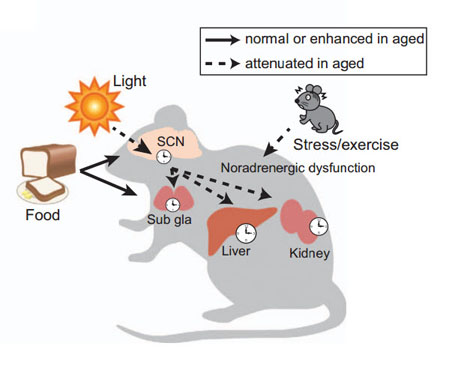末梢時計における交感神経系調節の機能障害が年齢関連の体内時計の不調をもたらす
Age-related circadian disorganization caused by sympathetic dysfunction in peripheral clock regulation
2017年1月5日 npj Aging 3, Article number:16030 (2017) doi:10.1038/npjamd.2016.30
概日リズム:高齢個体の時計は時間の刺激をどのように感知するのか

加齢は、睡眠覚醒周期を含む体の生理機能の昼夜変動を縮小させる。我々の体内時計の時間維持メカニズムは、明暗や食事など、日々の環境刺激に対する「同調」により行われている。早稲田大学の柴田重信らは、非侵襲的なマウス末梢時計イメージング法を利用することにより、年齢に関連する体内時計同調システムの変化の特徴を調べた。この研究により、高齢動物の交感神経性調節の弱体が中枢時計と末梢時計の間の内部時計情報シグナル伝達を弱め、光または運動/ストレスが誘導する時計同調の抑制を引き起こす一方で、食物が誘導する同調を増強することが明らかにされた。体内時計は恒常性に重要な役割を果たしているため、同調能力の特性を調べることは、年齢に関連する生理機能低下に対する優れた薬物治療戦略の発見に有益と考えられる。
Circadian rhythms: How aged clock senses time cue
Aging decreases day-night fluctuations of physiological functions in our body including sleep-wake cycle. Time-keeping mechanism of our clock is event of “entrainment” to daily environmental cues such as light-dark and food. Shigenobu Shibata from Waseda University in Japan and colleagues investigated a hallmark of age-related change of the circadian clock entrainment system by using non-invasive mouse peripheral clock imaging method. They found that weakened sympathetic regulations in aged animals attenuated internal clock information signaling between central and peripheral clocks, and caused the reduction of light-or exercise/stress-induced clock entrainment, but improved food-induced entrainment. Because circadian clock has an important role for homeostasis, investigating properties of entrainment ability will help us to find good medication strategy for age-related decline of physiological function.

